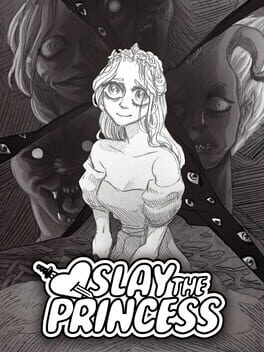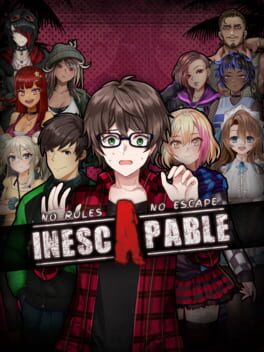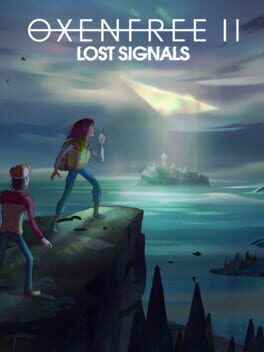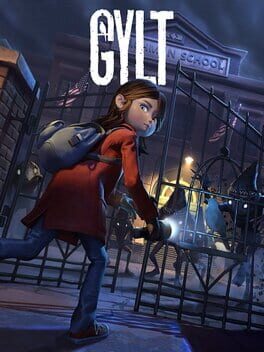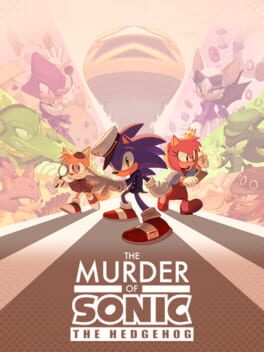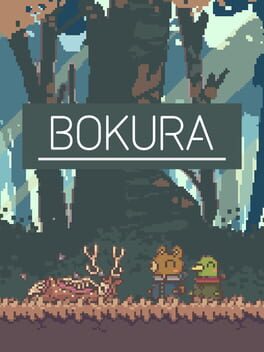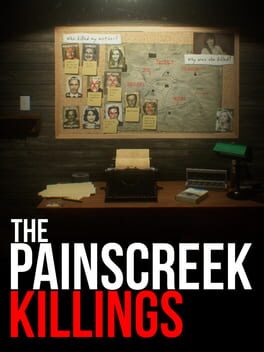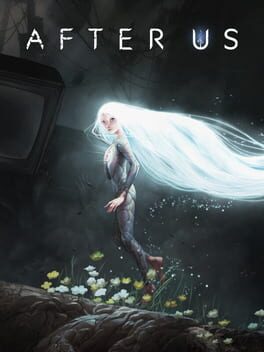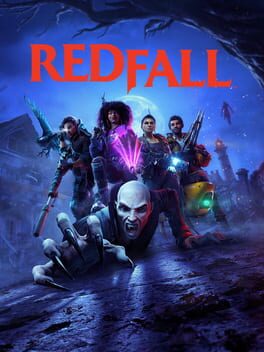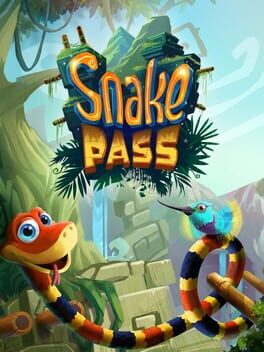Gandheezy22
2023
2023
Long ago, somewhere far away, a fisherman stepped onto an old, rickety boat. I never would have imagined that following his story, something so surreal and unrelatable to me, would be so... harrowing. Dredge not only tapped into a video game I did not know I desperately needed, and a gameplay loop I could not let go of, but it tapped into something in ME. Every time I saw something new this world surprised, shook, tested, and thrilled me. The pure bliss of gliding over the ocean with the satisfaction of snatching up a good catch met my spiritual need to feel completely out of my element. I don't understand anything about this world, despite understanding the story within it. Dredge is finally the idea of Eldritch horror done right in a video game, and it is a perfectly addicting loop of exploration, fishing, and upgrading at the same time. I will never, ever forget this journey through the archipelago and the care I took to fish but not overfish, explore but not disturb, and seek but never find.
Inescapable: No Rules, No Rescue is the worst game I have played this year for a one major reason: it has no idea what it is trying to do. The writers have no consistency in themes, storytelling, or even basic dialogue interactions. I'm kind of impressed that they wrote these many lines, because it is tens of thousands, and almost all of them are so, so bad. I hated every one of the characters more and more as the game progressed, especially my own character, and having no agency over him as he became a misogynistic human dumpster fire was frustrating to say the least. Having full voice acting that ranges from catastrophically bad at worst to passable at best does not help in any way, and the game insisting at the end that it was so frustratingly bad on purpose the whole time was insulting. I do not recommend Inescapable to anyone under any circumstances.
2023
Full review: https://gameluster.com/starfield-review-shoot-for-the-moon/
As I was soaring around the perimeter of Earth’s desolate moon, listening to Inon Zur’s masterful soundtrack and Sam telling his daughter a stupid joke, I couldn’t help thinking about what Todd Howard’s vision for this world was when he started jotting down notes for it 25 years ago. What parts of this are fulfilled fully? What parts of it were limited by technology or scope? Did it all come together the way he envisioned? When I touched down on an empty white rock hurtling through space at a million miles an hour and saw the American flag frozen in place where Neil Armstrong and Buzz Aldrin placed it thousands of years ago, I felt the answer was a quiet, reserved “yes”. With Starfield, Bethesda has shot for the moon and landed amongst the stars – and there are much less wondrous places to land. I am out here, insignificant, a dot amongst the field of stars, and my only wish is that it remains so vast that I may never measure it.
As I was soaring around the perimeter of Earth’s desolate moon, listening to Inon Zur’s masterful soundtrack and Sam telling his daughter a stupid joke, I couldn’t help thinking about what Todd Howard’s vision for this world was when he started jotting down notes for it 25 years ago. What parts of this are fulfilled fully? What parts of it were limited by technology or scope? Did it all come together the way he envisioned? When I touched down on an empty white rock hurtling through space at a million miles an hour and saw the American flag frozen in place where Neil Armstrong and Buzz Aldrin placed it thousands of years ago, I felt the answer was a quiet, reserved “yes”. With Starfield, Bethesda has shot for the moon and landed amongst the stars – and there are much less wondrous places to land. I am out here, insignificant, a dot amongst the field of stars, and my only wish is that it remains so vast that I may never measure it.
2023
2023
Pikmin never grabbed me as a child quite as much as Nintendo’s other franchises, and returning to the series as an adult I know why: Pikmin 1 is brutal. How children are meant to make it through a survival RTS game that has actual permadeath and requires you to burn through hundreds of soldiers to make a dent in the enemies, I will never know. But one thing that you may not know if you’re not a fan of the franchise is that every Pikmin game is wildly different, not just in the maps and mechanics, but in the core conceit of the game design. After the brutal survival challenge of Pikmin 1, the dungeon-crawling treasure hunt of Pikmin 2, and the mind-bending open zone puzzle tests of Pikmin 3, literally no one knew what to expect from Pikmin 4.
While not reaching the heights of Pikmin 3, one of my favorite video games of all time, Pikmin 4 delighted and surprised me by providing several campaigns and modes, each built in a different style, each one testing another part of my brain to its limit. After finishing the relatively easy 25 hour main campaign of Pikmin 4, you may be tempted to put down your controller and touch grass – not so fast! The postgame of Pikmin 4 offers some of the best content in the entire series, including a 4 hour Olimar campaign featuring the return of the permadeath clock and only the original 3 Pikmin types in a genuinely heart-pounding survival challenge. Add on the amazing treasure hunts, the dandori challenges, and the horde mode challenges and you’ve got another 30 hours of incredible real-time strategy fun that never takes its foot off the gas. Pikmin 4 features over a hundred enemy types, 10 Pikmin types, and some of the most creative and lovely level design I’ve seen in years.
Pikmin 4 is, without question, the most accessible game in the franchise. I don’t say that because the challenge of the previous games is gone, per se, but because Pikmin 4 aims to test every part of your resourcefulness in bite-sized chunks, rather than focusing the game’s design around one grueling type of challenge. In many ways, it’s a beautiful culmination of what Pikmin started as and what it is now. Pikmin 1 tests your survival skills on a permadeath ticking clock, Pikmin 2 tests your dungeon-crawling prowess against labyrinths of enemies and traps, Pikmin 3 breaks your mind by making you control three different characters at the same time across the map and constantly weighing opportunity cost of time to solve puzzles – Pikmin 4 does every one of these things over the course of the adventure, and it does them all really damn well. After 100%ing this game, all I can do now is sit here and ponder what wonderful new challenges Pikmin 5 will bring us one day.
While not reaching the heights of Pikmin 3, one of my favorite video games of all time, Pikmin 4 delighted and surprised me by providing several campaigns and modes, each built in a different style, each one testing another part of my brain to its limit. After finishing the relatively easy 25 hour main campaign of Pikmin 4, you may be tempted to put down your controller and touch grass – not so fast! The postgame of Pikmin 4 offers some of the best content in the entire series, including a 4 hour Olimar campaign featuring the return of the permadeath clock and only the original 3 Pikmin types in a genuinely heart-pounding survival challenge. Add on the amazing treasure hunts, the dandori challenges, and the horde mode challenges and you’ve got another 30 hours of incredible real-time strategy fun that never takes its foot off the gas. Pikmin 4 features over a hundred enemy types, 10 Pikmin types, and some of the most creative and lovely level design I’ve seen in years.
Pikmin 4 is, without question, the most accessible game in the franchise. I don’t say that because the challenge of the previous games is gone, per se, but because Pikmin 4 aims to test every part of your resourcefulness in bite-sized chunks, rather than focusing the game’s design around one grueling type of challenge. In many ways, it’s a beautiful culmination of what Pikmin started as and what it is now. Pikmin 1 tests your survival skills on a permadeath ticking clock, Pikmin 2 tests your dungeon-crawling prowess against labyrinths of enemies and traps, Pikmin 3 breaks your mind by making you control three different characters at the same time across the map and constantly weighing opportunity cost of time to solve puzzles – Pikmin 4 does every one of these things over the course of the adventure, and it does them all really damn well. After 100%ing this game, all I can do now is sit here and ponder what wonderful new challenges Pikmin 5 will bring us one day.
Oxenfree II is a very strange sequel, and certainly not one I expected after finishing Oxenfree in 2016. I played Oxenfree three more times over the last few years with different groups of friends, as it was one of my favorite games of that year, and I recommended it heartily to all fans of narrative-driven games. For those that don’t know, Oxenfree has nearly a dozen endings, with even the “true” ending being notoriously ambiguous. I was wondering how a direct sequel might even justify existing, and I think NightSchool Studios figured out the right approach. While it doesn’t quite hit as hard as the first game, Oxenfree II offers another thrilling pseudo-horror adventure that is well worth tuning into (get it?).
I’ll do my best to avoid spoilers for Oxenfree, because you really should play it before moving on to Lost Signals. It is possible to play and enjoy it standalone, but the last hour of the game isn’t going to make a lot of sense. In Lost Signals, 30-something Riley returns to her hometown of Carmena to investigate the mysterious radio signals that plague the airwaves – and possible reconnect with her estranged father. She quickly befriends Jacob, one of the few other people out and about on this warm summer night, and the two of them are thrown into a journey of introspection with terrible consequences. Set five years after the first game, the sequel focuses on the consequences of Alex’s actions and a strange cult that might just have harnessed the ghost radio’s abilities.
Gameplay is basically exactly like the first game. One of my complaints with Lost Signals is that mechanically, it is identical to its 7-year-old predecessor. If you’re not familiar, Oxenfree II is a narrative adventure game that presents itself in 2D as Riley explores a 3D world. It’s a bit hard to describe, but the setup does a good job of making the map feel open even though the exploration is very linear. You’re equipped with a radio (that later gets an upgrade to access more frequencies) that can disturb the environment, fight back ghosts, and seal portals.
You’ll also get a walkie-talkie, which you can use to chat with a number of interesting folk around Carmena and keep in touch with your tutorial-guide friend Evelyn. Outside of that, Oxenfree is a game about talking a lot while walking very, very slowly. And then getting scared right out of your pants.
Oxenfree‘s main unique feature is its dialogue, which pretty much makes or breaks the game for players. The dialogue is very, very conversational – so conversational, in fact, that it sounds wrong coming out of a scripted line. These conversations are recorded with the actors in the same room, facing each other, and with lots of improvisation, so the tone is constantly shifting the way that it would in real life. It’s kind of unnerving, and that’s why I love it, but I’ll admit a good number of people find it annoying.
Dialogue is not only very informal; It’s also very continuous. There aren’t timed and paced breaks between conversations and events, or even between characters speaking over each other and interrupting. It feels somewhat stressful, and adds to the horror in a new way. Oxenfree does this very unique thing very, very well.
Dialogue choices seem to have a great deal of effect on conversation, especially as you’re talking so much. It’s apparent later in the game how close Jacob feels to you, as you make dozens of casual dialogue choices that will affect what he thinks of you. There’s no “Jacob Will Remember That” in the corner – he just does, and you should know as a human from his tone of voice that it matters to him.
Thematically, I think Lost Signals flounders a little bit where Oxenfree did not. While the narrative is communicated effectively, it doesn’t seem to have had any last impact on me. In contrast, I thought about the purgatory-like ending of Oxenfree for weeks. The “difficult” choice at the end was not even a little difficult, and I could see from the ending statistics that 79% of players got the same ending I did. Maybe I’m predictable, but I think NightSchool could have maybe done a better job selling me on why the life of a 16 year old stranger who hates me might be more important than my own child.
I can’t say a whole lot more about this very narrative-focused game without spoiling the actual narrative, but I will comment that the artwork is as lovely as ever, and basically looks like a higher resolution of the same style from the first game. The music is equally haunting, and the use of sound cues is once again masterful. Oxenfree is themed closely around radio signals, so exploring the radio as you walk is sometimes pleasantly calming. Plus, you can meet some interesting friends on the airwaves that spice up the worldbuilding in a wonderful way.
I mostly played Oxenfree II on my Steam Deck, and though there was a little blurring on background environments even when set to 1200×800, it ran at a very smooth 60 FPS on high settings. I played for about an hour on my PC rig as well, which is a GTX 2060 Super and Ryzen 5 3600, where it predictably hit 1440p 144 FPS on ultra settings. I experienced zero bugs, glitches, or frame rate drops during my playthrough, a trend which seems to only describe indie PC games as AAA ports are less and less reliable.
Oxenfree II: Lost Signals delivers a smartly written sequel to a game I loved, and while the new characters and new island to explore do a lot, it’s a tad disappointing that it is mechanically unevolved. Nevertheless, this 6 hour trek across a mysterious island under the threat of a ghost invasion exceeded my expectations, and the thrilling tale is weakened only by its boring and obvious final choice. Jacob is a delightful companion and I loved having him along for the ride, and with just two main characters in Lost Signals instead of the five-person ensemble cast of Oxenfree, NightSchool does a much better job of building out the characters into real people. I recommend this game for everyone who enjoyed Oxenfree – while it may not wow you, it’s a worthy sequel to one of my favorite adventure games of all time.
I’ll do my best to avoid spoilers for Oxenfree, because you really should play it before moving on to Lost Signals. It is possible to play and enjoy it standalone, but the last hour of the game isn’t going to make a lot of sense. In Lost Signals, 30-something Riley returns to her hometown of Carmena to investigate the mysterious radio signals that plague the airwaves – and possible reconnect with her estranged father. She quickly befriends Jacob, one of the few other people out and about on this warm summer night, and the two of them are thrown into a journey of introspection with terrible consequences. Set five years after the first game, the sequel focuses on the consequences of Alex’s actions and a strange cult that might just have harnessed the ghost radio’s abilities.
Gameplay is basically exactly like the first game. One of my complaints with Lost Signals is that mechanically, it is identical to its 7-year-old predecessor. If you’re not familiar, Oxenfree II is a narrative adventure game that presents itself in 2D as Riley explores a 3D world. It’s a bit hard to describe, but the setup does a good job of making the map feel open even though the exploration is very linear. You’re equipped with a radio (that later gets an upgrade to access more frequencies) that can disturb the environment, fight back ghosts, and seal portals.
You’ll also get a walkie-talkie, which you can use to chat with a number of interesting folk around Carmena and keep in touch with your tutorial-guide friend Evelyn. Outside of that, Oxenfree is a game about talking a lot while walking very, very slowly. And then getting scared right out of your pants.
Oxenfree‘s main unique feature is its dialogue, which pretty much makes or breaks the game for players. The dialogue is very, very conversational – so conversational, in fact, that it sounds wrong coming out of a scripted line. These conversations are recorded with the actors in the same room, facing each other, and with lots of improvisation, so the tone is constantly shifting the way that it would in real life. It’s kind of unnerving, and that’s why I love it, but I’ll admit a good number of people find it annoying.
Dialogue is not only very informal; It’s also very continuous. There aren’t timed and paced breaks between conversations and events, or even between characters speaking over each other and interrupting. It feels somewhat stressful, and adds to the horror in a new way. Oxenfree does this very unique thing very, very well.
Dialogue choices seem to have a great deal of effect on conversation, especially as you’re talking so much. It’s apparent later in the game how close Jacob feels to you, as you make dozens of casual dialogue choices that will affect what he thinks of you. There’s no “Jacob Will Remember That” in the corner – he just does, and you should know as a human from his tone of voice that it matters to him.
Thematically, I think Lost Signals flounders a little bit where Oxenfree did not. While the narrative is communicated effectively, it doesn’t seem to have had any last impact on me. In contrast, I thought about the purgatory-like ending of Oxenfree for weeks. The “difficult” choice at the end was not even a little difficult, and I could see from the ending statistics that 79% of players got the same ending I did. Maybe I’m predictable, but I think NightSchool could have maybe done a better job selling me on why the life of a 16 year old stranger who hates me might be more important than my own child.
I can’t say a whole lot more about this very narrative-focused game without spoiling the actual narrative, but I will comment that the artwork is as lovely as ever, and basically looks like a higher resolution of the same style from the first game. The music is equally haunting, and the use of sound cues is once again masterful. Oxenfree is themed closely around radio signals, so exploring the radio as you walk is sometimes pleasantly calming. Plus, you can meet some interesting friends on the airwaves that spice up the worldbuilding in a wonderful way.
I mostly played Oxenfree II on my Steam Deck, and though there was a little blurring on background environments even when set to 1200×800, it ran at a very smooth 60 FPS on high settings. I played for about an hour on my PC rig as well, which is a GTX 2060 Super and Ryzen 5 3600, where it predictably hit 1440p 144 FPS on ultra settings. I experienced zero bugs, glitches, or frame rate drops during my playthrough, a trend which seems to only describe indie PC games as AAA ports are less and less reliable.
Oxenfree II: Lost Signals delivers a smartly written sequel to a game I loved, and while the new characters and new island to explore do a lot, it’s a tad disappointing that it is mechanically unevolved. Nevertheless, this 6 hour trek across a mysterious island under the threat of a ghost invasion exceeded my expectations, and the thrilling tale is weakened only by its boring and obvious final choice. Jacob is a delightful companion and I loved having him along for the ride, and with just two main characters in Lost Signals instead of the five-person ensemble cast of Oxenfree, NightSchool does a much better job of building out the characters into real people. I recommend this game for everyone who enjoyed Oxenfree – while it may not wow you, it’s a worthy sequel to one of my favorite adventure games of all time.
2019
Full review: https://gameluster.com/gylt-review-not-so-little-nightmares/
GYLT does a number of things very well, and even reminds me of masterpieces like Little Nightmares and INSIDE when it is at its best. The music is simultaneously gripping and haunting, the controlled atmosphere is intense, the 3D environments are dreadfully beautiful, and the few monsters that inhabit this world are either terribly interesting or just flat out scary. The stealth is fairly fun, although the enemy AI detection could use some tweaking, and the environmental puzzles are just challenging enough to be entertaining. I don’t know that there is one singular thing that GYLT does better than any other game, but outside of the poor story and theme exploration, it does everything else at least very well. Playing alongside a good friend so I didn’t get too scared resulted in a wonderful few nights, and if any of what I’ve said here sounds appealing, I heartily recommend GYLT.
GYLT does a number of things very well, and even reminds me of masterpieces like Little Nightmares and INSIDE when it is at its best. The music is simultaneously gripping and haunting, the controlled atmosphere is intense, the 3D environments are dreadfully beautiful, and the few monsters that inhabit this world are either terribly interesting or just flat out scary. The stealth is fairly fun, although the enemy AI detection could use some tweaking, and the environmental puzzles are just challenging enough to be entertaining. I don’t know that there is one singular thing that GYLT does better than any other game, but outside of the poor story and theme exploration, it does everything else at least very well. Playing alongside a good friend so I didn’t get too scared resulted in a wonderful few nights, and if any of what I’ve said here sounds appealing, I heartily recommend GYLT.
This is the first ever 11/10. Sorry, video games. And our base-10 number system. You are now both obsolete.
One day maybe I'll come to grips with the fact that Nintendo dropped one of the best games of all time, went radio silent for 6 years, and then dropped an even better sequel. When I played Breath of the Wild, I called it a 10, so I'm going to leave it at that, but frankly Tears of the Kingdom improves every single aspect of Breath of the Wild so much I don't think I could ever bring myself to play the first game again.
I think Eiji Aonuma has earned a long, happy retirement after this, and he's obviously trained Hidemaro Fujibayashi to adequately take his place in the future. Zelda is at its best when it has reinvented itself, it always has been. Tears of the Kingdom is a reinvention of a reinvention. It's hard to believe video games will ever get better than this, but that's what I said 6 years ago - and how delighted I am to be proved wrong.
One day maybe I'll come to grips with the fact that Nintendo dropped one of the best games of all time, went radio silent for 6 years, and then dropped an even better sequel. When I played Breath of the Wild, I called it a 10, so I'm going to leave it at that, but frankly Tears of the Kingdom improves every single aspect of Breath of the Wild so much I don't think I could ever bring myself to play the first game again.
I think Eiji Aonuma has earned a long, happy retirement after this, and he's obviously trained Hidemaro Fujibayashi to adequately take his place in the future. Zelda is at its best when it has reinvented itself, it always has been. Tears of the Kingdom is a reinvention of a reinvention. It's hard to believe video games will ever get better than this, but that's what I said 6 years ago - and how delighted I am to be proved wrong.
2023
2023
...I would forgive a lot of these frustrations if After Us was simply fun to play, but it isn’t. At no point did physically playing this game feel good. There are some beautiful landscapes to walk around, and spirit animals are always fun, but everything from the controls to the level design to the structure of the game is badly done. There is obviously some heart behind this, but it feels like a poor execution on every level. I care about our environmental impacts as much as anyone and believe we need to be responsible for how we as a species have created hardship for other species, but I also believe that yelling “you and everything you love are bad” at people does about as much to inspire environmental activism as hitting them over the head with a bag of carrots.
Read my full review here: https://gameluster.com/review-after-us-maddening-mindless-menagerie/
Read my full review here: https://gameluster.com/review-after-us-maddening-mindless-menagerie/
2023
I cannot, and will not believe that the same studio who made Prey, perhaps the greatest video game of all time, produced this absolute trash fire. There is no trace of Arkane in here. There is barely a trace of video game in here. It's only redeeming qualities are good enough music and the character art reminding me how good the character designs in Dishonored are.
Play Prey. Even if you have Game Pass, don't waste your time on this. Play Prey instead.
Play Prey. Even if you have Game Pass, don't waste your time on this. Play Prey instead.
2017
